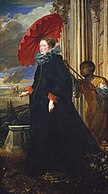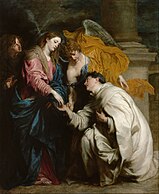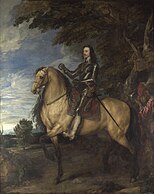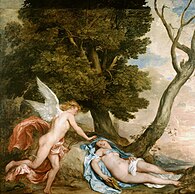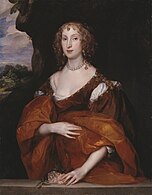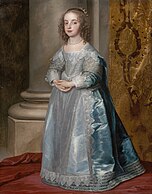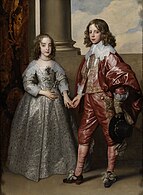Anthony van Dyck
Self-Portrait with a Sunflower (after 1633) | |
|---|---|
| Born | Anthonio van Dyck[1] 22 March 1599 |
| Died | 9 December 1641 (aged 42) |
| Nationality | Flemish |
| Education | Hendrick van Balen, Peter Paul Rubens |
| Known for | Painting |
| Movement | Baroque |
| Spouse |
Mary Ruthven (m. 1640) |
| Signature | |
 | |
Sir Anthony van Dyck (Dutch: Antoon van Dyck [ˈɑntoːɱ vɑn ˈdɛik];[a] 22 March 1599 – 9 December 1641)[3] was a Flemish Baroque artist who became the leading court painter in England after success in the Spanish Netherlands and Italy.
The seventh child of Frans van Dyck, a wealthy silk merchant in Antwerp, Anthony painted from an early age. He was successful as an independent painter in his late teens and became a master in the Antwerp Guild on 18 October 1617.[4] By this time, he was working in the studio of the leading northern painter of the day, Peter Paul Rubens, who became a major influence on his work.
Van Dyck worked in London for some months in 1621, then returned to Flanders for a brief time, before travelling to Italy, where he stayed until 1627, mostly in Genoa. In the late 1620s he completed his greatly admired Iconography series of portrait etchings of mainly other artists and other famous contemporaries. He spent five years in Flanders after his return from Italy, and from 1630 was court painter for the Archduchess Isabella, Habsburg Governor of Flanders. At the request of Charles I of England he returned in 1632 to London as the main court painter.
With the exception of
His influence extends into the modern period. The Van Dyke beard is named after him. During his lifetime, Charles I granted him a knighthood, and he was buried in St Paul's Cathedral, an indication of his standing at the time of his death.
Life and work
Family and early life
Anthony van Dyck was born in Antwerp on 22 March 1599 as the seventh of 12 children of his parents. He was baptized the next day in the Onze-Lieve-Vrouwekerk (now the

After his birth his family moved to a house called the Kasteel van Rijssel (Castle of Lille) in the Korte Nieuwstraat. His mother died when he was only 8 years old. At the time the family was living in a more luxurious house in the Korte Nieuwstraat called the Stadt van Ghent (City of Ghent).[5] His artistic talent was evident very early. When he was 10 years old, he started his formal training as a painter with Hendrick van Balen the Elder. Van Balen was a successful painter of small cabinet paintings who had multiple pupils. It is not known how long he studied with van Balen, and estimates vary from two to four years. While it was common for apprentices to stay on in their master's workshop until they were formally registered as a master in the local guild, van Dyck is believed to have left his master's workshop in 1615 or 1616 to set up his independent workshop before he became a master. The reason was that in that period his father was experiencing financial difficulties and could use any assistance he could get. It was during the period van Dyck may have started painting the series of panels of Christ and the Apostles in bust-length, although it is also possible that this only happened after his first return from Italy in 1620-21.[6][5]
By the age of fifteen he was already a highly accomplished artist, as shown by his Self-portrait dated 1613–14.[7] He was admitted to the Antwerp Guild of Saint Luke as a free master on Saint Luke's day, 18 October 1617.[4]
Within a few years he became the chief assistant to Peter Paul Rubens, the leading master painter of Antwerp and the whole of Northern Europe. Rubens operated a large workshop and often relied on sub-contracted artists. His influence on the young artist was immense. Rubens referred to the nineteen-year-old van Dyck as "the best of my pupils".[8]
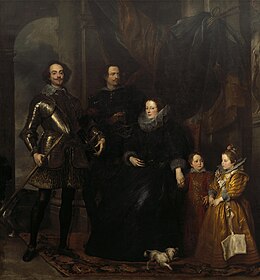
The origins and exact nature of their relationship are unclear. It has been speculated that van Dyck was a pupil of Rubens from about 1613, as even his early work shows little trace of van Balen's style, but there is no clear evidence for this.[9]
At the same time the dominance of Rubens in the relatively small and declining city of Antwerp probably explains why, despite his periodic returns to the city, van Dyck spent most of his career abroad.
Italy
In 1620, at the instigation of

He returned to Flanders after about four months, and then left in late 1621 for Italy, where he remained for six years. There he studied the Italian masters while starting a successful career as a portraitist. He was already presenting himself as a figure of consequence, annoying the rather bohemian Northern artist's colony in

He was mostly based in
For the Genoese aristocracy, then in a final flush of prosperity, he developed a full-length portrait style, drawing on Veronese and Titian as well as Rubens' style from his own period in Genoa, where extremely tall but graceful figures look down on the viewer with great hauteur. In 1627, he went back to Antwerp where he remained for five years, painting more affable portraits which still made his Flemish patrons look as stylish as possible. A life-size group portrait of twenty-four City Councillors of Brussels he painted for the council-chamber was destroyed in 1695.[17] He was evidently very charming to his patrons, and, like Rubens, well able to mix in aristocratic and court circles, which added to his ability to obtain commissions. By 1630, he was described as the court painter of the Habsburg Governor of Flanders, the Archduchess Isabella. In this period he also produced many religious works, including large altarpieces, and began his printmaking.
London and death
King Charles I was the most passionate collector of art among the
Van Dyck remained in touch with the English court and helped King Charles's agents in their search for pictures. He sent some of his own works, including a self-portrait (1623) with

He was well paid for his paintings in addition to this, at least in theory, as King Charles did not actually pay over his pension for five years and reduced the price of many paintings. He was provided with a house on the River Thames at Blackfriars, then just outside the City of London, thus avoiding the monopoly of the Worshipful Company of Painter-Stainers. A suite of rooms in Eltham Palace, no longer used by the royal family, was also put at his disposal as a country retreat. These residences were managed by his partner Margaret Lemon.[20]
His Blackfriars studio was frequently visited by the King and Queen (later a special causeway was built to ease their access), who hardly sat for another painter while van Dyck lived.[9][17]
He was an immediate success in England, where he painted large numbers of portraits of the King and Queen, as well as their children. Many portraits were done in several versions, to be sent as diplomatic gifts or given to supporters of the increasingly embattled king. Altogether van Dyck has been estimated to have painted forty portraits of King Charles himself, as well as about thirty of the Queen, nine of the Earl of Strafford, and multiple ones of other courtiers.[21] He painted many of the court, and also himself and his mistress, Margaret Lemon.[20]
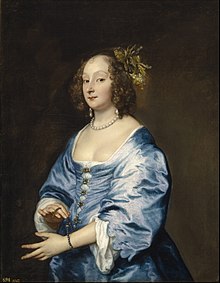
In England he developed a version of his style which combined a relaxed elegance and ease with an understated authority in his subjects which was to dominate English portrait-painting to the end of the 18th century. His portraits of Charles on horseback updated the grandeur of Titian's Equestrian Portrait of Charles V, but even more effective and original is his portrait of Charles dismounted in the Louvre: "Charles is given a totally natural look of instinctive sovereignty, in a deliberately informal setting where he strolls so negligently that he seems at first glance nature's gentleman rather than England's King".[22] Although his portraits have created the classic idea of "Cavalier" style and dress, in fact a majority of his most important patrons in the nobility, such as Lord Wharton and the Earls of Bedford, Northumberland and Pembroke, took the Parliamentarian side in the English Civil War that broke out soon after his death.[17]
The King
A letter dated 13 August 1641, from Lady Roxburghe in England to a correspondent in The Hague, reported that van Dyck was recuperating from a long illness.[27] In November, van Dyck's condition worsened, and he returned to England from Paris, where he had gone to paint Cardinal Richelieu.[27] He died in Blackfriars, London on 9 December 1641, the same day as the baptism of his daughter Justiniana.[28] He was buried on 11 December, in the choir of St Paul's Cathedral. His mortal remains and tomb (erected by the king) were destroyed in the Great Fire of London in 1666.[29][30]
Portraits and other works

In the 17th century, demand for portraits was stronger than for other types of work. Van Dyck tried to persuade Charles to commission large-scale series on the history of the
A list of history paintings produced by van Dyck in England survives. It was compiled by van Dyck's biographer Bellori, based on information from
Van Dyck's portraits flattered more than Velázquez's. When Sophia of Hanover, first met Queen Henrietta Maria, in exile in Holland in 1641, she wrote: "Van Dyck's handsome portraits had given me so fine an idea of the beauty of all English ladies, that I was surprised to find that the Queen, who looked so fine in painting, was a small woman raised up on her chair, with long skinny arms and teeth like defence works projecting from her mouth..."[9]
Some critics have blamed van Dyck for diverting a nascent, tougher English portrait tradition—of painters such as William Dobson, Robert Walker and Isaac Fuller—into what certainly became elegant blandness in the hands of many of van Dyck's successors, like Lely or Kneller.[9] The conventional view has always been more favourable: "When Van Dyck came hither he brought Face-Painting to us; ever since which time ... England has excel'd all the World in that great Branch of the Art" (Jonathan Richardson: An Essay on the Theory of Painting, 1715, 41). Thomas Gainsborough is reported to have said on his deathbed "We are all going to heaven, and Van Dyck is of the Company."[17]

A fairly small number of
Printmaking
Probably during his period in Antwerp after his return from Italy, van Dyck began his Iconographie, which became a very large series of prints with half-length portraits of eminent contemporaries. He produced drawings, and for eighteen of the portraits he himself etched the heads and main outlines of the figure, for an engraver to work up: "Portrait etching had scarcely had an existence before his time, and in his work it suddenly appears at the highest point ever reached in the art".[33]

He left most of the printmaking to specialists, who engraved after his drawings. His etched plates appear not to have been published until after his death, and early states are very rare.[34] Most of his plates were printed after only his work had been done. Some exist in further states after engraving had been added, sometimes obscuring his etching. He continued to add to the series until at least his departure for England, and presumably added Inigo Jones whilst in London.
The series was a great success, but was his only venture into printmaking; portraiture probably paid better. At his death there were eighty plates by others, of which fifty-two were of artists, as well as his own eighteen. The plates were bought by a publisher; with the plates reworked periodically as they wore out they continued to be printed for centuries, and the series added to, so that it reached over two hundred portraits by the late 18th century. In 1851, the plates were bought by the Calcographie du Louvre.[34]
The Iconographie was highly influential as a commercial model for reproductive printmaking; now forgotten series of portrait prints were enormously popular until the advent of
Etchers have studied Van Dyck ever since, for they can hope to approximate his brilliant directness, whereas nobody can hope to approach the complexity of Rembrandt's portraits.[35]
Studio

Van Dyck's success led him to maintain a large workshop in London, which became "virtually a production line for portraits". According to a visitor he usually only made a drawing on paper, which was then enlarged onto canvas by an assistant; he then painted the head himself. The costume in which the client wished to be painted was left at the studio and often with the unfinished canvas sent out to artists specialised in rendering such clothing.[17] In his last years these studio collaborations accounted for some decline in the quality of work.[36]
In addition many copies untouched by him, or virtually so, were produced by the workshop, as well as by professional copyists and later painters. The number of paintings ascribed to him had by the 19th century become huge, as with Rembrandt,
The relatively few names of his assistants that are known are Dutch or Flemish. He probably preferred to use trained Flemish artists, as no equivalent English training existed in this period.[9] Van Dyck's enormous influence on English art does not come from a tradition handed down through his pupils. In fact it is not possible to document a connection to his studio for any English painter of any significance.[9] Dutchman Adriaen Hanneman (1604–1671) returned to his native city, The Hague in 1638 to become the leading portraitist there.[37]
Flemish painter Pieter Thijs studied in van Dyck's workshop as one of van Dyck's last pupils. He became a very successful portrait and history painter in his native Antwerp.[38]
Legacy
Much later, the styles worn by his models provided the names of the
A confusing number of different pigments used in painting have been called "Vandyke brown" (mostly in English-language sources). Some predate van Dyck, and it is not clear that he used any of them.[41] Van Dyke brown is an early photographic printing process using the same colour.
When van Dyck was
Collections

The British
Tate Britain held the exhibition Van Dyck & Britain in 2009.[52] In 2016 the Frick Collection in New York had an exhibition "Van Dyck: The Anatomy of Portraiture", the first major survey of the artist's work in the United States in over two decades.[53]
The estate of the Earl Spencer at Althorp houses a small collection of van Dycks including War and Peace (Portrait of Sir George Digby, 2nd Earl of Bristol, English Royalist politician with William Russell, 1st Duke of Bedford), which is the most valuable painting in the collection and the favourite of the earl.[54]
Gallery
-
Christ carrying the Cross
-
Prado
-
Luigia Cattaneo-Gentile, Genoa, c. 1622
-
Elena Grimaldi, Genoa, 1623
-
Anton Giulio Brignole-Sale, Genoa, c. 1627
-
Nicholas Lanier, 1628
-
The Vision of the Blessed Hermann Joseph c. 1629–30
-
Marie-Louise de Tassis, Antwerp, 1630
-
Venetia Stanley on her Death Bed, 1633, Dulwich Picture Gallery
-
Charles I at the Hunt, c. 1635, Louvre
-
Katherine, Countess of Chesterfield, and Lucy, Countess of Huntingdon, c. 1636–40, oil on canvas, Yale Center for British Art
-
Equestrian Portrait of Charles I, c. 1637–38
-
Cupid and Psyche, 1638
-
Princess Mary, Daughter of Charles I, about 1637, Museum of Fine Arts, Boston
-
The apostle Matthew, Royal Museum of Fine Arts Antwerp
-
Portrait of Sir George Digby, 2nd Earl of Bristol, English Royalist politician with William Russell, 1st Duke of Bedford ("War and Peace"), 1637, Althorp
-
Portrait of Jacques Le Roy, 1631. Thyssen-Bornemisza Museum, Madrid.
-
Rachel de Ruvigny, Countess of Southampton, c. 1640, National Gallery of Victoria
-
Portrait of Mary, daughter of Charles I with her husband the Prince of Orange, 1641. Rijksmuseum, Amsterdam.
See also
Notes
- ^ In Dutch, his first name is also attested as Anthonis or Antonie; in French, as Antoine; in Italian, as Antonio or Anthonio. In English, a capitalised "Van" in "Van Dyck" was more usual until recent decades (used by Waterhouse for example), and the "Dyke" spelling was often used during his lifetime and later (and is usual for the beard style). The Dutch "Dyck" is an old-fashioned contraction of the spelling "Dijck", with the "IJ" digraph.[2]
References
- ^ a b Moortgat, Ingrid. “Baptism of Antonio Van Dyck.” In Jordaens Van Dyck Panel Paintings Project. Edited by Joost Vander Auwera and Justin Davies, accessed 21 February 2024
- ^ ULAN entry.
- ^ "Anthony van Dyck". Netherlands Institute of Art. Retrieved 14 February 2024.
- ^ a b Davies, Justin. 'A new date for Anthony van Dyck's free mastership'. The Burlington Magazine 165 (February 2023), pp. 162–165.
- ^ a b c d Van der Stichelen, Katlijne. Young Anthony: Archival Discoveries Relating to Van Dyck's Early Career. Studies in the History of Art, vol. 46, 1994, pp. 16–46. JSTOR, Accessed 21 Feb. 2024.
- ^ a b Jeremy Wood, 'Sir Anthony van Dyck', in the Oxford Dictionary of National Biography, ed. H.C.G. Matthew and Brian Harrison, Oxford, 2004, XVII, pp. 466–475
- ISBN 0-300-10469-3
- ^ Brown, p. 17.
- ^ a b c d e f g h i j k Ellis Waterhouse, Painting in Britain, 1530–1790, 4th Edn, 1978, pp. 70–77, Penguin Books (now Yale History of Art series)
- ^ Martin, op and page cit.
- ^ Brown, page 19.
- ^ Levey, Michael, Painting at Court, Weidenfeld & Nicolson, London, 1971, pp. 124–5
- ^ Cotter, Holland (29 July 2005). "Desperately Painting the Plague". The New York Times.
- ^ Bailey, Gauvin Alexander (1 March 2012). "Van Dyck in Sicily: while the plague held Palermo in its grip, Anthony van Dyck radically developed 12th-century iconography of Saint Rosalie through five paintings that imbued the saint with a sensual refinement. Van Dyck's Rosalie became one of Catholicism's most popular images of victory over pestilence, and represents a key period in the artist's development". Apollo. 175 (596): 116–122 – via go.gale.com.
- ^ "2012: Van Dyck in Sicily | Dulwich Picture Gallery". www.dulwichpicturegallery.org.uk.
- ^ Farago, Jason (26 March 2020). "The Saint Who Stopped an Epidemic Is on Lockdown at the Met". The New York Times.
- ^ a b c d e f Cust 1899.
- ^ Grosvenor Gallery; Stephens, F.G. (1887). Exhibition of the Works of Sir Anthony Van Dyck. H. Good and Son, Printers. p. 14.
About the end of March or the beginning of April, 1632, Van Dyck arrived in England; he was almost immediately appointed Principal Painter in Ordinary to the King, knighted, presented with a gold chain, similar to that which had been given to ...
- ISBN 978-0-8047-2261-2.
- ^ required.)
- ^ Gaunt, William, English Court Painting.
- ^ Levey, p. 128
- ^ Wood (2010)
- ISBN 9780300212051.
- ^ Cokayne, G. E., et al, The Complete Peerage, vol.iv, London, 1916, p. 385n
- ^ "Portret królewicza". Treasures... (in Polish). Archived from the original on 27 June 2009. Retrieved 29 August 2008.
- ^ a b Michael Jaffé. "Dyck, Anthony van". Grove Art Online. Oxford Art Online. Oxford University Press. Web.
- ^ Wood (2010)
- ^ Wood (2010)
- Sinclair, W.p99: London; Chapman & Hall, Ltd; 1909
- ^ Levey, op cit p. 136
- ISBN 0-7141-2621-7
- ^ ISBN 0-486-20954-7
- ^ ISBN 0-931537-15-0
- ISBN 0-691-00326-2
- ^ Brown, pp. 84–86.
- ISBN 978-1-85709-362-9
- ^ Hans Vlieghe, "Thijs, Pieter." Grove Art Online. Oxford Art Online. Oxford University Press. 22 August 2019.
- ISBN 978-0-313-33664-5.
His style coined the names of the van Dyke beard, for the sharply pointed and trimmed goatees popular for men in the first half of the century, and the van Dyke collar, a wide collar across the shoulders edged copiously with lace.
- ISBN 0571049028
- ISBN 1136373926, 9781136373923, google books
- ISBN 978-1-250-02492-3.
Van Dyck was knighted and anglicised his name to Vandyke.
- ISBN 9780954044336.
- ^ Royal Collection Archived 3 February 2014 at the Wayback Machine Paintings by Van Dyck
- ^ "Dyck, Anthony van – The Collection – Museo Nacional del Prado". www.museodelprado.es. Retrieved 4 April 2020.
- ^ "Portrait of Jacques Le Roy". Museo Nacional Thyssen-Bornemisza. Retrieved 3 April 2020.
- ^ "Christ on the Cross". Museo Nacional Thyssen-Bornemisza. Retrieved 3 April 2020.
- ^ "Annotated works | The Bilbao Fine Arts Museum". www.museobilbao.com. Retrieved 3 April 2020.
- ^ Fernando, Real Academia de BBAA de San. "Dyck, Antonio van – La Virgen y el Niño con los pecadores arrepentidos". Academia Colecciones (in Spanish). Retrieved 3 April 2020.
- ^ "Anton Van Dyck". www.culturaydeporte.gob.es (in Spanish). Retrieved 3 April 2020.
- ^ "'Retrato ecuestre de Francisco de Moncada' de Van Dyck – Noticias – Generalitat Valenciana". www.museobellasartesvalencia.gva.es. Retrieved 3 April 2020.
- ISBN 978-1-85437-795-1.
- ^ "Past Exhibition: Van Dyck". The Frick Collection.
- ISSN 0307-1235. Archived from the originalon 26 February 2016. Retrieved 4 April 2019.
Sources
- Brown, Christopher: Van Dyck 1599–1641. Royal Academy Publications, 1999. ISBN 0-900946-66-0
- Cust, Lionel Henry (1899). "Van Dyck Anthony". Retrieved 28 April 2018 – via Wikisource.
- Wood, Jeremy (27 May 2010). "Dyck, Sir Anthony Van (1599–1641)". doi:10.1093/ref:odnb/28081. (Subscription or UK public library membershiprequired.)
External links
- The Oliver Millar Archive; research papers of Oliver Millar, British art historian and a leading authority on Anthony van Dyck
- The National Portrait Gallery: Van Dyck
- Royal Collection Trust. Inventory no. 404429.
- Jordaens Van Dyck Panel Paintings Project




